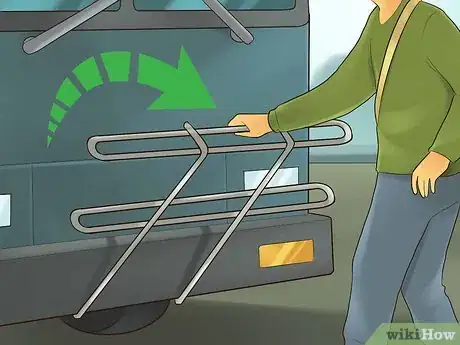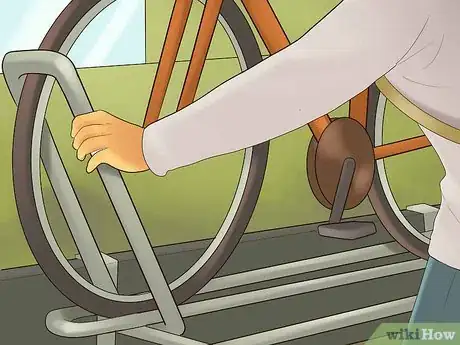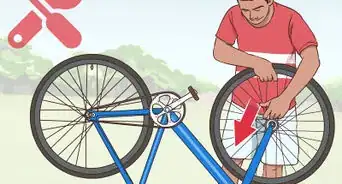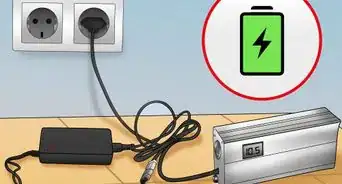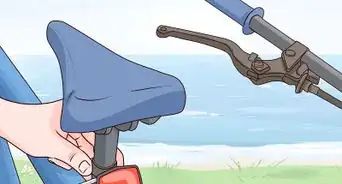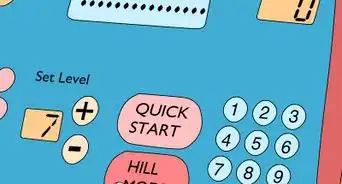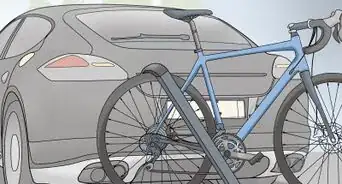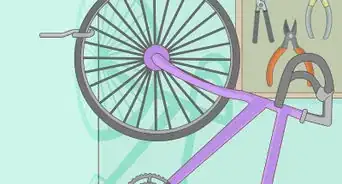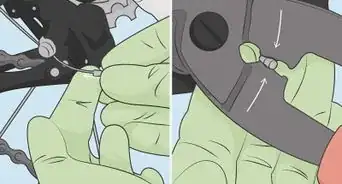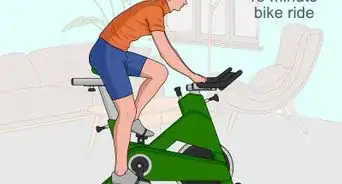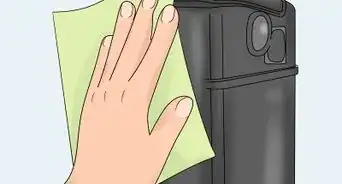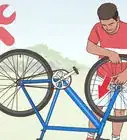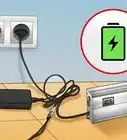This article was co-authored by wikiHow staff writer, Amber Crain. Amber Crain has been a member of wikiHow’s writing staff for the last six years. She graduated from the University of Houston where she majored in Classical Studies and minored in Painting. Before coming to wikiHow, she worked in a variety of industries including marketing, education, and music journalism. She's been a radio DJ for 10+ years and currently DJs a biweekly music program on the award-winning internet radio station DKFM. Her work at wikiHow supports her lifelong passion for learning and her belief that knowledge belongs to anyone who desires to seek it.
This article has been viewed 44,972 times.
Learn more...
Many people prefer using their bicycles for transportation. However, when you have to travel beyond a certain distance, this becomes less feasible. Most city buses come equipped with bike racks positioned on the front bumper. You can mount your bike there, hop on the bus, and travel to your destination easily. Remove loose items from your bike while you wait for the bus, alert the driver that you’re using the rack, then cross in front of the bus to easily mount your bike.
Steps
Waiting at the Bus Stop
-
1Remove loose items and bike accessories before the bus comes. Arrive at the bus stop several minutes early and prepare your bike for loading while you wait. Remove water bottles, bike pumps, panniers, and any other loose or detachable items from your bike. If you don’t, your bike may not fit on the rack properly.
- Bring a backpack so you can place your loose items and bike accessories into it. You'll need to have your hands free to load your bike on the rack.
- All additional baggage must accompany you onto the bus. You cannot strap your backpack to the rack or your bicycle.[1]
-
2Be ready to load your bike from the curb side of the bus. Always wait for the bus on the curb. Do not approach the bus from the street side, because the bus driver may not see you. Never approach a bus while you’re actually riding your bike. You should be dismounted from your bike and ready to load before the bus arrives.[2]Advertisement
-
3Wait for the bus to stop completely before stepping in front of it. Stay on the curb until the bus comes to a full stop. Do not step into the street as it approaches. If it’s dark outside and you’re afraid the driver won’t see you waiting on the curb, consider packing a small flasher light with you. Use it to hail the bus as it approaches.[3]
-
4Make eye contact to alert the driver you're loading your bike. You don’t need to board the bus and verbally alert the bus driver that you want to use the bike rack. Make eye contact, nod, point to your bike, and give a friendly wave. Wait for the bus driver to acknowledge you before you step in front of the bus to approach the rack.
-
5Fold up your bike and take it on board with you, alternatively. If your bike can be folded up or collapsed, you can usually board the bus with it. You won’t have to use the rack in this case. Your bike must collapse to be the size of a standard piece of luggage. When you get on board with your bike, position it under the seat and keep it clear of the aisle.[4]
Loading Your Bike on the Rack
-
1Walk in front of the bus toward the bike rack. Bike racks are located on the front bumper of most city buses. As your bus approaches, you’ll be able to tell if the bus is equipped with a rack and if there are other bikes already mounted on it. Bike racks usually have a max capacity of 2 to 4 bikes. Wait until the next bus if the bike rack is already fully occupied.
-
2Squeeze and pull the handle to lower the bike rack. Squeezing the handle releases the locking pin. You only need to do this if there are no other bikes on the rack. If there are other bikes already mounted on the rack, the rack will already be lowered for you.[5]
-
3Hoist your bike by the seat tube and stem. The seat tube is right under the bike seat, and the stem is the horizontal bar that connects the front and rear wheels of your bike. Place one hand on each area and use your arms to hoist the bike up. Holding the bike from this position provides the most leverage and stability.[6]
-
4Slide your bike wheels into the positions provided. You will see fitted slots on the bike rack for your bike wheels to slide into. Check the rack for directions about whether you should load in your front or rear wheel first, since this varies. In most cases, the slots will be clearly labeled for you.
- If the rack is vacant, use the slot closest to the bus.
- If other bikes are already mounted, use the closest slot to the bus that’s available.
-
5Lift the support arm over the front tire and secure it. Pull the support arm out completely, then pull it up and over your front tire. Make sure to secure the support arm against the top of the front tire. It should not rest against the fender or brake.[7]
- On some racks, you may need to push a button at the end of the support arm to release it and pull it out. If the arm doesn’t move when you pull it, look for the release button and press it.
- Do not use your personal bike lock to secure your bike to the rack.[8]
-
6Sit near the front and keep an eye on your bike. Board the bus and pay your fare, as you normally would. You won’t have to pay extra for mounting your bike. Find a seat near the front of the bus and sit there so you can keep an eye on your bike during the ride. Don’t take your eyes off your bike during stops, since this is when theft usually occurs.[9]
-
7Consider practicing on a demonstration rack, if possible. Many cities provide demonstration racks for riders to practice on before attempting to mount their bike in a real-life scenario. Things can go wrong and hold up the bus, which they want to avoid. Practicing beforehand also gives you peace of mind regarding the safety of your bike when on the rack. Check your city’s public transit website for more information.[10]
Exiting the Bus and Unloading Your Bike
-
1Alert the driver that you’re unloading your bike before you exit. Let the bus driver know you need to get your bike off the rack at the next stop. It’s usually best to do this verbally, to ensure the bus driver hears and understands you. Make sure the driver acknowledges your statement before you get off the bus.[11]
- If you don’t alert the driver before you exit, they may drive off with your bike still on the rack.
- If this happens, check your local transit website for instructions. There’s usually a Lost and Found Department or a phone number you can contact.
-
2Exit through the front door of the bus. This is a good time to remind the bus driver that you need to remove your bike from the rack. Give them a wave, or point at the rack, to remind them. Make eye contact with the driver as you do so. Do not step in front of the bus until you’ve made eye contact and you’re sure the bus driver sees you.[12]
-
3Unload your bike on the curb side of the street. Never unload on the street side. The bus driver won’t have a good view of you, and you’ll be exposed to oncoming traffic. When you exit the bus through the front exit, walk in front of the bus and toward the bike rack.
-
4Raise the support arm and lift your bike out of the fitted slots. Lift up the support arm that’s secured to your front tire. Pull it over the front tire, and then lower it and push it out of the way, against the front of the bus. Hoist your bike by the seat tube and stem, just as you did when you loaded it.[13]
- If you had to press a button to release the support arm, you may need to listen for a “click” that tells you it’s back in position.
-
5Fold up the bike rack if it’s empty. If your bike was the only one mounted to the rack, squeeze the handle and then return the rack to the upright, folded position. If there are other bikes on the rack, simply remove yours from the fitted slots and step away from the rack.[14]
-
6Carry your bike to the curb. Once you have your bike securely in your hands, walk to the closest curb. Do not mount your bike and ride away from the bus. Do not walk toward the street side. Wait until the bus leaves before you get on your bike and ride away.[15]
References
- ↑ http://www.transitchicago.com/riding_cta/how_to_guides/bikebus.aspx
- ↑ http://metro.kingcounty.gov/tops/bike/#how-to-load
- ↑ https://www.metrotransit.org/bike-n-ride-bus
- ↑ https://trimet.org/bikes/bikesonbuses.htm
- ↑ https://www.metrotransit.org/bike-n-ride-bus
- ↑ https://www.metrotransit.org/bike-n-ride-bus
- ↑ https://www.metrotransit.org/bike-n-ride-bus
- ↑ http://www.transitchicago.com/riding_cta/how_to_guides/bikebus.aspx
- ↑ https://trimet.org/bikes/bikesonbuses.htm






